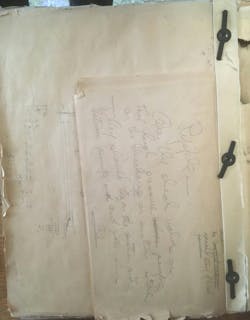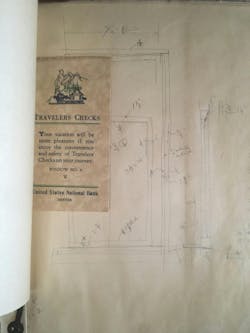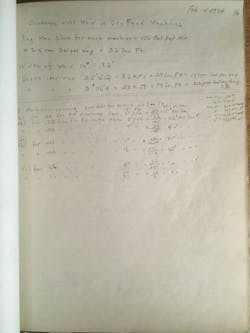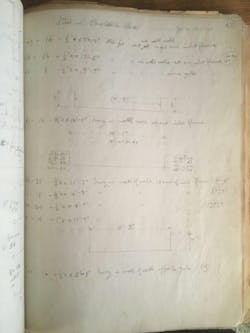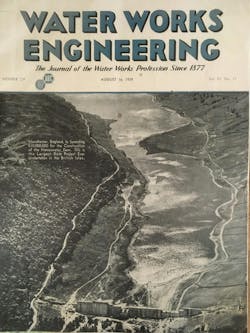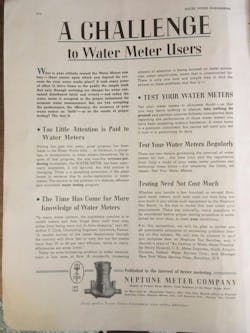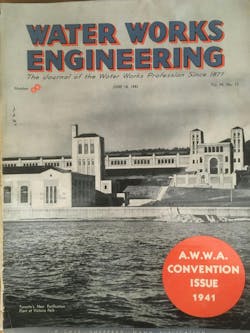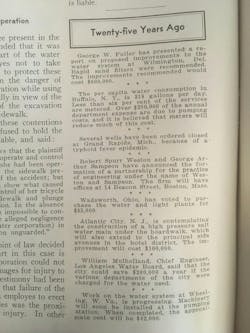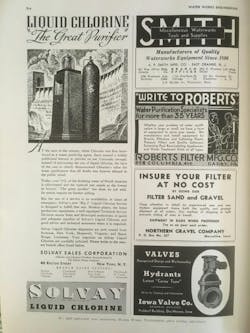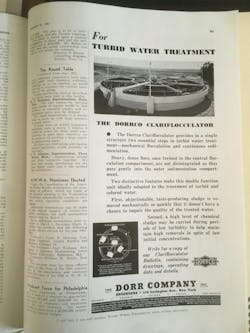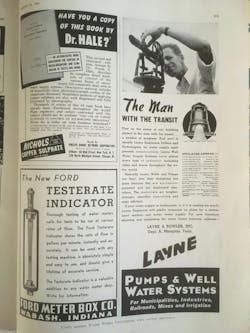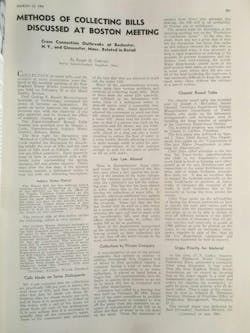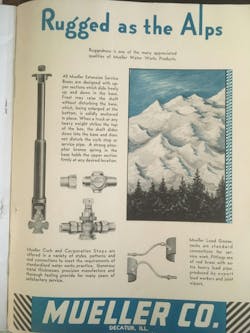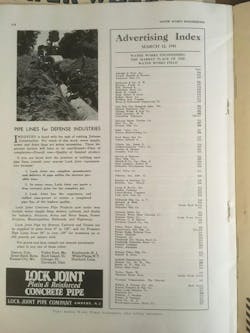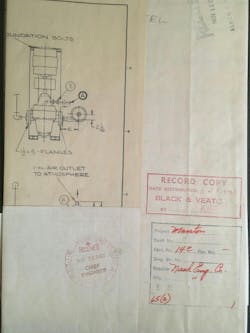The Marston Water Treatment Plant (WTP) is one of three major treatment facilities serving Denver, Colorado. At its peak, the facility can provide 220 million gallons per day (mgd).
Endeavor Business Media water group editors took a tour of the facility on an off day from AWWA ACE25 and happened upon some interesting vestiges from 100 years ago, at the plant's beginning.
A hundred years from today, what will be left behind in your plant for future water professionals?
The 1924 Technical Manual
Manual of Specifications, Drawings and Description of Equipment for Size L-1 Nash Hytor Vacuum Pump.
Manual cover page for contract “A” Filter Plant, Marston Lake, North Side and Contract “B” [illegible] for filter plant, Marston Lake January, 1924 to December, 1924, belonging to O. J. Ripple. Another name on the cover page is James Fuertes, a consulting engineer who became a member of AWWA in 1906 (page 46).
A Note to O. J. Ripple from W.
Ripple — Are the check valves on the high pressure pumps on the discharge or suction side [?] They should be on the suction side between pump side and gate valve —W.
From a hundred years ago, tucked inside the first page of the handwritten manual, there is bric-a-brac, a reminder, a memento, or “desk junk”?
February 4, 1924 notes.
June 7, 1924 notes.
Water Industry Trade Publication Selections from 1939 - 1941
August 16, 1939 Water Works Engineering cover story: “Manchester, England is Spending £10,000,000 for Construction of the Haweswater Dam. This is the Largest Dam Project Ever Undertaken in the British Isles.” In today’s money, that would be about £566,293,300 according to rough calculations at Bank of England’s online inflation calculator.
August 16, 1939 Neptune Meter Company, “Makers of Trident Water Meters ‘Cash Registers of the Water Works Field’ 50 West 50th St. (Rockefeller Center), New York City,” publishes an advertisement for their equipment known as Neptune Test Bench “in the interest of better metering.”
August 16, 1939 Water Works Engineering staff writers put together a report entitled “Who Attends Water Works Conventions?” proclaiming, “Conventions of the American Water Works Association, like the New York World’s Fair, are wonderfully worthwhile, stimulating shows that do not seem to be adequately attended!”.
The magazine documents,
“Manufacturers have estimated the cost of putting on a big water works exhibit like that at Atlantic City at considerably more than $200,000. This includes the rental of exhibit space and furniture; decorating the booths; preparing, packing, shipping and setting up the individual exhibits; operating them with staffs of trained salesmen, often with higher executives of the companies in attendance, and their time, travel expenses and entertainment.”
In 2025, that $200,000 estimate would be equivalent to $4.6 million according to the U.S. Bureau of Labor Statistics Inflation Calculator. Editor’s note: this figure is mentioned twice, so it is unlikely an error.
The report also notes that only “six percent of all communities [with service areas] above 2,500 were represented!” with the majority being 55% of cities with populations over 100,000.
It seems this number was unsatisfactory to the authors; the teaser reads, “Analysis of Registration at the Last A.W.W.A Annual Meeting, Showing Just Which Cities Sent Delegates — Suggestions to Assure Wider Representation at Future Conventions.”
June 18, 1941 A.W.W.A. convention issue cover.
March 12, 1941 Water Works Engineering cover, “Lights From the Main Treatment Plant of Kansas City, Mo. Water Plant Reflected by One of the Settling Basins.”
The city could save $200,000 a year if the various departments of the city were charged for the water used.
March 12, 1941 In a retrospective section, “Twenty-five Years Ago,” historical news highlights per capita water consumption in Buffalo, N.Y. to have been 318 gallons per day, although “less than six percent of the services are metered.” In Wadsworth, Ohio, the “water and light plants” were to be purchased for $85,000 (a steal at approximately $1.8 million in 2025).
One entry read, “Robert Spurr Weston and George Arthur Sampson have announced the formation of a partnership for the practice of engineering under the name Weston and Sampson. The firm will have offices at 14 Beacon Street, Boston, Mass.”
Weston and Sampson in 2025 is a full-service environmental and infrastructure consulting firm, remains an employee held company (is not publicly traded) and has an estimated annual revenue of $135.5 million along with over 900 employees.
Another says that William Mullholland, chief engineer of the Los Angeles Water Board “said that the city could save $200,000 a year if the various departments of the city were charged for the water used.”
In Grand Rapids, Mich., wells were ordered closed because of a typhoid fever epidemic. The local newspaper from October 23, 1896 read (in the second column under the heading “NEWS FOR MICHIGANDERS.”) “Litchfield has an epidemic of typhoid fever. Two members of the Wilson family died.”
In fact, typhoid outbreaks were quite common during this time, and although not all typhoid outbreaks were attributable to water supply, cities were motivated to work on cleaner waterways.
March 12, 1941 An advertisement for “Liquid Chlorine ‘The Great Purifier’” argues that “at the turn of the century, when Chlorine was first introduced as a water purifying agent, there ensued a widely publicized lawsuit to prevent its use” alongside the Roberts Filter Manufacturing Company and the Northern Gravel Company.
March 12, 1941 O. J. Ripple’s work at Marston is featured in Water Works Engineering.
March 12, 1941 The wonders of modern engineering.
*Unfortunately, because of the cost of preparation of this book, it is necessary to limit its distribution to those who are professionally occupied with this subject.
March 12, 1941 Phelps Dodge Refining Corporation sponsored a 44-page free book about the use of copper sulfate to control microscopic organisms. The advertisement notes “*Unfortunately, because of the cost of preparation of this book, it is necessary to limit its distribution to those who are professionally occupied with this subject.” Requests must be written for on business letterhead.
In 2007, Phelps Dodge was acquired for $26 billion and became part of Freeport-McMoRan Copper & Gold Inc.
March 12, 1941 World War II, evacuations, duties of the turncocks, shift work, the water supply, and “the well-to-do.”
March 12, 1941 Methods of Collecting Water Bills discussed at the New England Water Works Association: Naughty or Nice?
Roger Oakman, water superintendent in Needham, Mass. reported it this way. “Mr. Cook started off the discussion by describing briefly the types of bills and the stub forms used at Auburn [Maine].”
Cook is reported to have said that thirty days after the due date, if the account remained unpaid, “a delinquent notice is sent out with the following inscription: The Water Bill for the address below remains unpaid. [ … ] If this account is not paid on or before the date below, it will be necessary to shut off the water at this address.”
Oakman continued to report by writing, “The reverse side of this notice carries the following, which is very unique:
The Auburn Water District belongs to its citizens. Its Trustees endeavor to give the best possible services at a minimum of costs to the people. Experience has proved that a rigid system of collection, enforced without discrimination is better for all concerned. The amount of each bill is small but the total of many such bills is considerable. Prompt payment will avoid much expense and loss.
Suggestions or complaints from consumers will receive cheerful consideration, at the office. We wish to impress the fact that the interests of the consumers are identical with those of the District and whatever helps the District will also benefit the consumer.”
The article states that in Auburn near 100% of past due bills were collected before the next bills went out (per quarter), and Mr Cook ended up making about 3% house calls on still-outstanding bills in any given quarter.
On the other side of the spectrum, Oakman reported how different superintendents handled non-payment writing that, “some used the trickle system, so that if a person was back on his payments and the money was not forthcoming, the curb cock would be practically closed or a slug put into a meter coupling to reduce the flow of water to a mere trickle, thereby allowing a person to drain enough water to meet his sanitary requirements if he had patience enough to wait for the glass or pitcher to fill up with water.”
March 12, 1941 Meuller advertisement: the only one in color, and in premium placement inside the back cover.
March 12, 1941 Advertiser index.
In 1965 Twenty years after O. J. Ripple’s handwritten manual, the chief engineer stamps equipment receipts from Nash Engineering and Black & Veatch.
Nash is speculated to have been bankrupted by asbestos litigation in 2021.
Black & Veatch, which was 50 years established in 1965, is, in 2025, an employee owned company with 12,000 employees, has made it on Forbes lists six times, most recently for America’s Top Private Companies (#143 in 2024), America’s Best Employers for Engineers (#121 in 2025), and reportedly had $4.75 billion in revenue in 2024.
About the Author

Mandy Crispin
Mandy Crispin is the editor-in-chief of WaterWorld magazine and co-host of water industry podcast Talking Under Water. She can be reached at [email protected].


![Manual cover page for contract “A” Filter Plant, Marston Lake, North Side and Contract “B” [illegible] for filter plant, Marston Lake January, 1924 to December, 1924. Another name on the cover page is James Fuertes, a consulting engineer who became a member of AWWA in 1906 (page 46). Manual cover page for contract “A” Filter Plant, Marston Lake, North Side and Contract “B” [illegible] for filter plant, Marston Lake January, 1924 to December, 1924. Another name on the cover page is James Fuertes, a consulting engineer who became a member of AWWA in 1906 (page 46).](https://img.waterworld.com/files/base/ebm/ww/image/2025/06/68630973065b58ad7159b67f-2_manual_cover_page_.png?auto=format,compress&fit=max&q=45?w=250&width=250)
